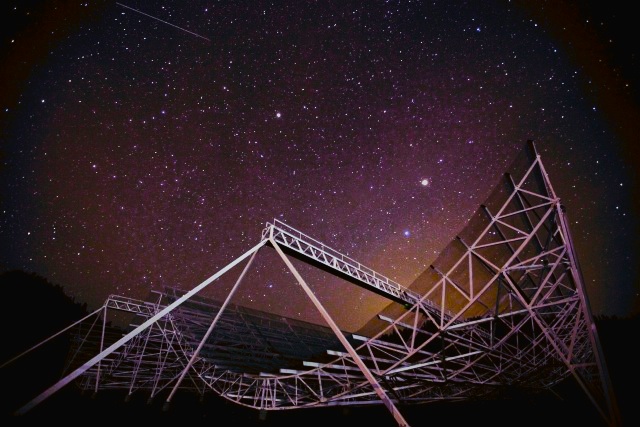Space. The first image that comes to mind is probably the night sky, a tranquil blanket of empty blackness dotted with twinkling stars, but this image is deceiving. Not only are stars much more sparse in the universe than the sky may lead one to believe, but the vast voids of space that lie between them are neither empty nor quiet. Cosmic objects like stars, pulsars, and supernovae all emit electromagnetic radiation—ranging from gamma waves to radio waves—that travel at the speed of light in every direction. Modern astronomers know the causes of most of these phenomena, but some remain mysteries.
One of these unresolved types of radiation are fast radio bursts (FRBs), which are extremely short but intense pulses of radio waves. FRBs are of great interest, according to Director of the McGill Space Institute and professor of physics Victoria Kaspi, because of their unusual and still mysterious characteristics.
“They appear to be ubiquitous, […] but they haven’t been predicted and [they] weren’t expected, and so we really don’t know what they are,” Kaspi said.
Only 18 different FRBs have ever been detected by astronomers, although Kaspi estimates that around 1,000 hit the Earth every day.
Earlier this month, astronomers identified, for the first time, the galaxy from which one of these FRBs originates, marking a breakthrough in the subject. The discovery was only possible due to previous work done in 2015 by Paul Scholz, a McGill PhD student. Scholz found a recurring, albeit unpredictable, pattern of a particular FRB. Scholz’s discovery allowed a team led by Dr. Shriharsh Tendulkar, one of Kaspi’s postdoctorate students, to search for the FRB with a higher-precision radio telescope. The signal’s origin was identified to be a dwarf galaxy about three billion light years away from the Milky Way, providing key information for further discovery.
“If you see something that seems bright, it could be intrinsically faint but really close to us, but if it’s really far away, then it’s intrinsically incredibly bright and some physical process has to be able to produce a huge amount of energy,” Kaspi explained. “We’ve suspected for a long time that [FRBs are coming] from very, very large distances, which would imply that they have very high energies [….] We were able to measure the distance to this galaxy [from which the FRB originated] and that was the proof that we were looking for.”
Not much else is known about this galaxy, although Kaspi expects to soon see images from the Hubble telescope that would offer more information.
The next step in the quest to understand FRBs will likely involve the Canadian Hydrogen Intensity Mapping Experiment (CHIME), a new radio telescope being built in British Columbia as a collaboration between the University of British Columbia, McGill University, and the University of Toronto. Kaspi is a senior member of the team developing CHIME, which is expected to be complete by the end of 2017. CHIME will be Canada’s largest radio telescope, and its 1,024 antennae spread across four cylindrical reflectors will handle as much data every day as the global cellphone network does. CHIME will be capable of collecting data from a large section of the sky, which, according to Kaspi, may allow it to detect dozens of FRBs every day.
“I feel like Canada should know that we’re doing this,” Kaspi said, as she showed pictures of the telescope. “It’s a really amazing thing. It’s unique in the world.”
If all goes well, CHIME will position Canadian researchers at the forefront of the study of FRBs over the coming years and provide astronomers with the information they need to fully understand the cause of these mysterious signals.








